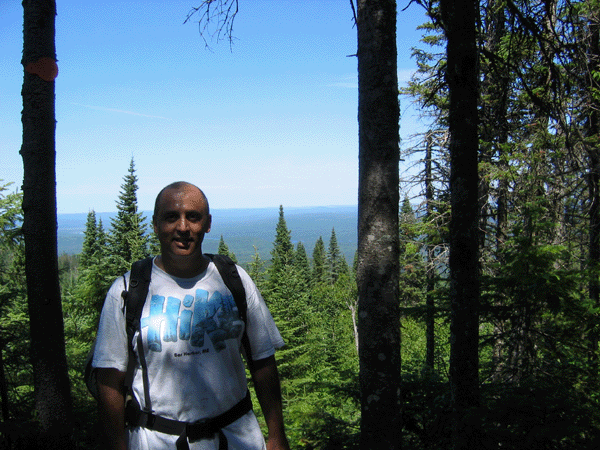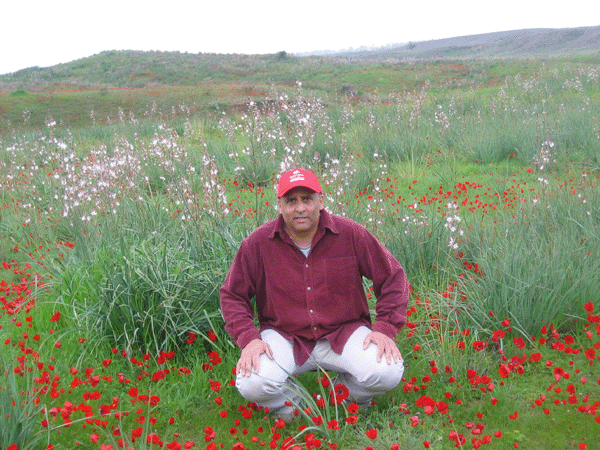Lecturer in Ecology
Dept. of Life Sciences
POB 653
Beer Sheva 84105, Israel

Lab #:
Fax #:
E-mail:
+972-8-6479230
oferovad@bgu.ac.il
| Ofer
Ovadia Lecturer in Ecology Dept. of Life Sciences POB 653 Beer Sheva 84105, Israel |
 |
|
|
Office #: Lab #: Fax #: E-mail:
|
+972-8-6461359 +972-8-6479230 oferovad@bgu.ac.il |
|
| My scientific worldview is based on an evolutionarily and ecologically mechanistic approach, combining field experimentation with computer simulation of natural data and or analytical models. My research aim is to understand how genetic and phenotypic (i.e., morphology, behavior and life history) variation change along geographical scales and to evaluate the consequent effects of such variation on population and community dynamics. |
 |
 |
| Date of Birth: | November 6, 1963 | |
| Place of Birth: | Beer-Sheva, Israel | |
| Nationality: | Israeli | |
| Marital status: | Married + 3 | |
| Military Service: | 1981-1986 Rank: Lieutenant Colonel. |
| 1987-1990: | B.Sc., Department of Life Sciences, Ben-Gurion University of the Negev, Beer-Sheva, Israel. | |
| 1990-1993: | M.Sc., with distinction, Department of Life Sciences, Ben-Gurion University of the Negev, Beer-Sheva, Israel. | |
| 1993-1999: | Ph.D., Department of Life Sciences, Ben-Gurion University of the Negev, Beer-Sheva, Israel. | |
| 1999-2004: | Post Doctoral Fellow, School of Forestry and Environmental Studies, Yale University, New Haven, CT, USA. | |
| 2004-2008: | Lecturer, Department of Life sciences, Ben-Gurion University of the Negev, Israel. | |
| 2008-present: | Senior Lecturer, Department of Life sciences, Ben-Gurion University of the Negev, Israel. |
| 1999-Present: | Reviewed articles for Animal Behavior, Behavioral Ecology, Ecology, Ecology Letters, Oecologia, and Oikos. | |
| 2005-Present: | Editor for Israel Journal of Zoology. |
| 1996-Present: | The Ecological Society of America, Washington, DC, USA. | |
| 1996-Present: | International Society for Behavioral Ecology, Oxford, UK. | |
| 1996-Present: | Association for the Study of Animal Behaviour, Cambridge, UK. |
| 1996-1999: | Clore Scholarship - A Project of the Charles Clore 1979 Israel Foundation (A National honorary award for excellence in graduate studies in the field of Natural Sciences). | |
| 1999-2001: | Fulbright fellowship for post doctoral studies - Research Award in Environmental Science in the USA. | |
| 1999-2001: | The Gaylord Donnelley Environmental Fellowship Post Doctoral fellowship, Yale Institution for Biospheric Studies, Yale University. |
| 2005-2006: | Israel Science Foundation. Research equipment grant for a new faculty. $122,000. | |
| 2005-2009: | Israel Science Foundation. Consequences of variation in morphological and life history traits among individuals on their population demography. $156,000, 4-yrs. | |
| 2006-2007: | Israel Nature and Parks Authority. Scaling-up from movement pattern to reserve management - linking movement pattern and spatial distribution to habitat heterogeneity in two endangered species, Testudo werneri and Meriones sacramenti, and in the outbreak species Vulpes vulpes. $20,000, 1-yr. | |
| 2007-2008: | Israel Ministry of Science. Applying advanced GIS-based methodology and ecological theory for conservation planning and management of endangered species at Agur Sands: Testudo werneri and Meriones sacramenti. $44,000, 1-yr. |
| 2001-2004: | Landscape Ecology Course for Graduate Students, School of Forestry and Environmental Studies, Yale University, New Haven, CT, USA. | |
| 2002-2003: | Community Ecology Course for Graduate Students, School of Forestry and Environmental Studies, Yale University, New Haven, CT, USA. | |
| 2003-2004: | Research Methods Course for Graduate Students, School of Forestry and Environmental Studies, Yale University, New Haven, CT, USA. | |
| 2004-present: | Lab
in Plant Sciences Course for Undergraduate Students, Department of
Life Sciences, Ben-Gurion University of the Negev, Beer-Sheva, Israel
(Jointly taught with Dr. |
|
| 2004-Present: | Plant
Sciences Course for Undergraduate Students, Department of Life
Sciences, Ben-Gurion University of the Negev, Beer-Sheva, Israel (Jointly
taught with Dr. |
|
| 2004-Present: | Population Ecology Course for Graduate & Undergraduate Students, Department of Life Sciences, Ben-Gurion University of the Negev, Beer-Sheva, Israel. | |
| 2004-Present: | Ecology
B Course for Undergraduate Students, Department of Life Sciences,
Ben-Gurion University of the Negev, Beer-Sheva, Israel (Jointly taught
with Prof. |
|
| 2004-Present: | Departmental
Seminar Course for Graduate Students, Department of Life Sciences, |